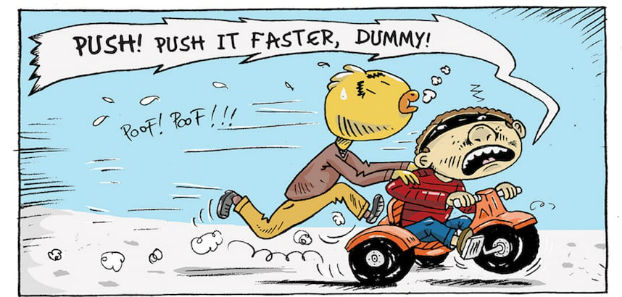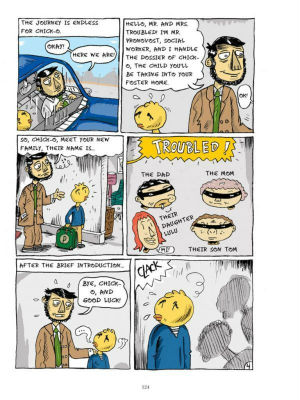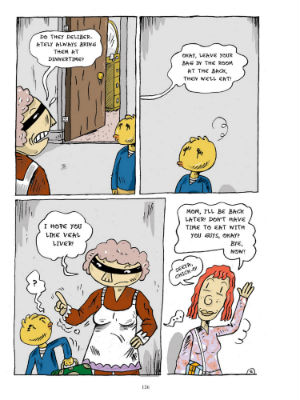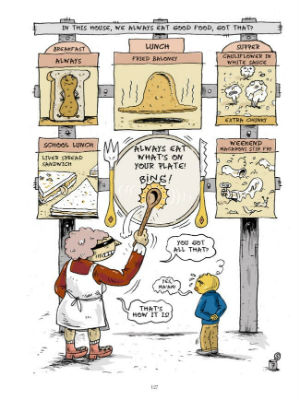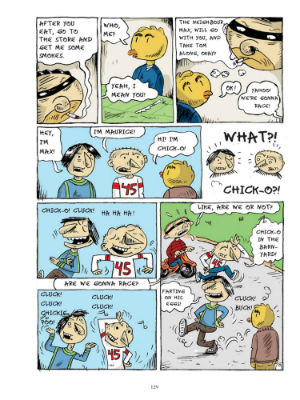Combining the starkest humour, a line in energetic yet bleak slapstick, and the rawest autobiography, The Vagabond Valise by Siris (published by Conundrum Press) traces the artist’s story from the first meeting of his parents – the indolent and unreliable Renzo and the caring but doomed Luce – through to his late teenage years. Siris’s on-page, bird-headed incarnation Chick-O endures a catalogue of mistreatment and personal setbacks in 1960s-’70s Quebec, all exacerbated by an officialdom that is more concerned with process and regulations than the isolated and unloved children who are so profoundly affected by its failings.
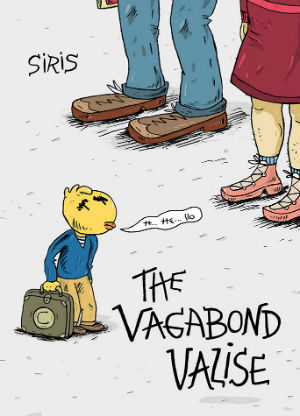 The Vagabond Valise initially introduces us to the wayward Renzo and focuses on his courtship of Luce, a union that will result in five children of which Chick-O is the youngest. Renzo’s alcoholism ensures that the family’s circumstances continue to degenerate and leads to the children all eventually being taken into care. Separated from each other, it means that Chick-O finds himself shuffled from foster family to foster family, becoming as much an outsider at home as he is in the clique-led politics of the schoolyard. Art will prove to be his one escape from the pressures of his otherwise lonely and oppressive existence.
The Vagabond Valise initially introduces us to the wayward Renzo and focuses on his courtship of Luce, a union that will result in five children of which Chick-O is the youngest. Renzo’s alcoholism ensures that the family’s circumstances continue to degenerate and leads to the children all eventually being taken into care. Separated from each other, it means that Chick-O finds himself shuffled from foster family to foster family, becoming as much an outsider at home as he is in the clique-led politics of the schoolyard. Art will prove to be his one escape from the pressures of his otherwise lonely and oppressive existence.
Though it’s an unrelentingly grim piece of storytelling there’s still something utterly compelling about the artist’s account of his formative years in these pages. Perhaps that’s because there’s such candour and uncompromising honesty to The Vagabond Valise that we become inextricably invested in its protagonist to the point that his tiniest moments of respite from the sheer misery of his environment become mini victories in themselves. Or maybe it’s because throughout the seemingly neverending humiliation and degradation the central character endures there’s a vein of the darkest, most biting humour in evidence.
From foster parents adorned with a less refined version of Dickensian naming conventions (Mr. and Mrs. Inconstant, for example, or Mr. and Mrs. Troubled whose imposing presence is memorably captured on the book’s cover) to the procession of tormentors that Chick-O encounters in almost every aspect of his daily routine, this is never an easy read. When he does finally make a genuine friend at school fate intervenes in the cruelest way possible. It’s a sequence that is heartrending in its injustice but one that feels horribly inevitable at the same time.
What elevates The Vagabond Valise beyond just affecting autobio is Siris’s constant inventiveness with the page. It both subverts and manipulates the very structure of panel-to-panel storytelling and combines that with frequent sideteps into powerful visual metaphor. In one scene the children become anthropomorphic suitcases proceeding down a conveyor belt to their next foster homes. Panels are often embedded into the action of larger illustrations with billboards, windscreens or gravestones becoming both fixtures within pages and part of their sequential flow at the same time. Chick-O’s terror of maths as his homework comes to life around him is particularly memorable in this respect.
Lettering also adds to the drama of events either in its direct reflection of emotion or by other clever representational tricks – its placement to obscure the face of one of the book’s more unpleasant temporary parents emphasises his overbearing tyranny by symbolically dehumanising him.
In the book’s final third there’s a feeling perhaps not so much of hope but at least that the abject helplessness that has permeated every page – the idea of a protagonist swept along by the whims of others and the irresponsibility of an uncaring system – is reaching an end. Indeed, a touching coda acts as thematic exorcism of sorts. Part social record and part unburdening of emotional baggage, The Vagabond Valise is the first English language graphic novel from Siris and one that has left me hoping similar translations of the work of this truly distinctive talent will not be long in coming.
Siris (W/A) • Conundrum Press/BDANG, $25.00
Review by Andy Oliver





